Table A. Comparative Construction Statistics from Approved Building Permits Cagayan: 1st Quarter of 2025 and 2024
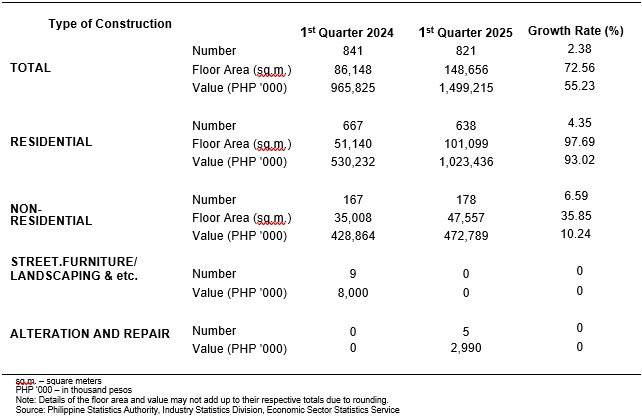
- Number of Constructions
Residential building constructions had the highest number of constructions
The number of constructions from approved building permits in Cagayan reached 638 in the 1st quarter of 2025, reflecting 2.38 percent decline compared to the same period in 2024. This data is based on approved building permits issued by the Local Building Officials (LBOs) in the Province of Cagayan.
In Figure 01, residential building constructions recorded the highest number of approved building permits in the 1st quarter of 2025 with actual of 638 constructions accounting for 77.71 percent of all approved constructions. This presents a 4.35 percent decrease compared to the same period in 2024. Among residential construction types, single-type houses dominated with 622 constructions comprising 97.49 percent of total residential buildings, this was followed by apartment/accessorial units with 11 constructions (1.72 percent) and duplex with 5 constructions (0.78 percent).
Meanwhile, the number of non-residential building constructions reached at 178 in the 1st quarter of 2025, accounting for 21.68 percent of the total number of constructions. This reflects a 6.59 percent increase compared to the 167 non-residential constructions recorded during the same quarter in 2024.
By type, commercial buildings registered the highest number with 152 constructions, accounting for 85.39 percent of the total non-residential category.
This was followed by institutional buildings with 20 constructions (11.24 percent) and industrial buildings, with 4 constructions (2.25 percent). Only 1 construction each was recorded for agricultural and other non-residential types, each representing 0.66 percent of the total non-residential constructions. (Figure 01b and Table A)
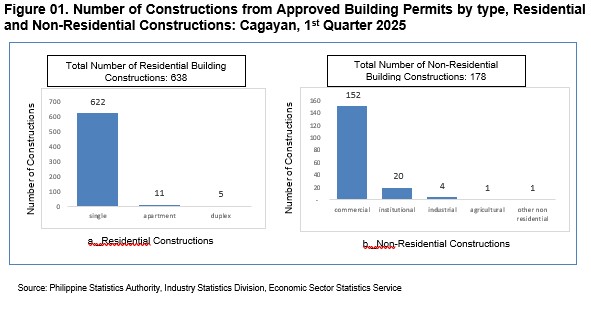
2. Value of Constructions
Residential building constructions recorded the highest value of constructions
The total value of constructions from approved building permits in Cagayan for the 1st quarter of 2025 reached PHP 1.50 billion, marking a 55.23 percent increase from the PHP 965.83 million recorded in the same period in 2024. (Table A)
Residential building constructions accounted for the highest total value in the 1st quarter of 2025, reaching approximately P H P 1.02 billion or 68.26 percent of the total value of construction. This represents an increase of 93.02 percent compared to the PHP 530.23 million recorded in the same period in 2024. (Table A) accounted
Among residential buildings, single-type residential buildings registered the highest construction value at PHP 742.03 million accounting for 72.50 percent of the total residential construction value. This contributed to the overall increase in the residential building construction during the 1st quarter of 2025. (Table A and Figure 02a)
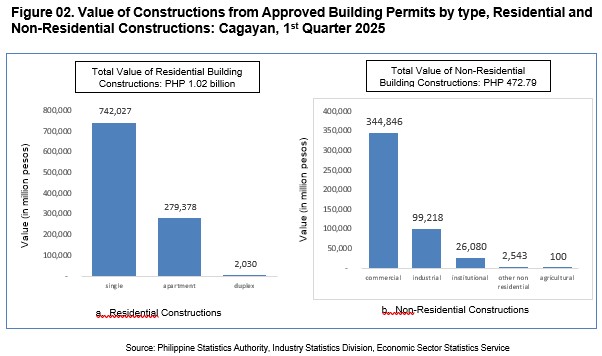
The value of non-residential building constructions in the 1st quarter of 2025 reached PHP 472.79 million reflecting a 10.24 percent increase from the PHP 428.86 million recorded in the same period in 2024. Commercial building constructions contributed the largest share amount to PHP 344.85 million a 72.94 percent of the total value of non-residential building constructions. (Table A and Figure 02b)
3. Floor Area
Residential building constructions accounted for more than half of the total floor area of constructions
The total floor area of constructions in 1st quarter of 2025 was recorded 148,656 square meters. This figure excludes constructions such as alterations and repairs, other non-residential structures (e.g., facade, helipad, niche, water tank) and other types, like street furniture, landscaping, and signboards, as these do not have reported floor areas. The total floor area in 1st quarter of 2025 registered an annual increment of 72.56 percent compared to the 86,148 square meters recorded in the same period in 2024. (Table A)
Residential building constructions recorded 101,099 square meters, or 68.00 percent of the total floor area of constructions in the 1st quarter of 2025. This represents an increase of 97.69 percent compared to the 51,140 square meters recorded in the 1st quarter of 2024. (Table A)
Among residential building constructions, single-type houses recorded an average floor area of 72,947 square meters. While duplex-type constructions recorded at 203 square meters. (Figure 03a)
Furthermore, non-residential building constructions recorded a total floor area of 47,557 square meters in the 1st quarter of 2025, accounting for 31.99 percent of the total floor area of constructions. This reflects a 35.85 percent increase compared to the 35,008 square meters reported in the same quarter in 2024. (Table A)
Among non-residential building constructions, commercial buildings reported the highest total floor area at 33,375 square meters. On the other hand, industrial constructions registered the lowest floor area at 2,609 square meters during the 1st quarter of 2025. (Figure 03b and Table A)
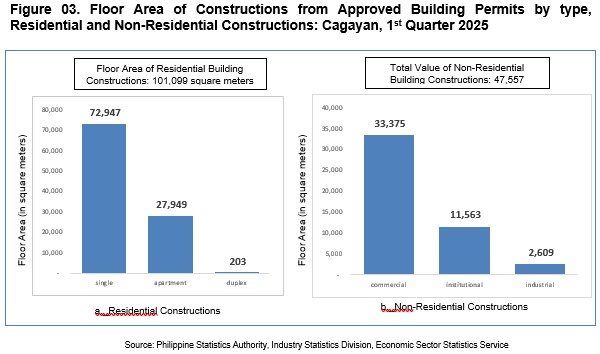
4. Average Cost of Construction
Residential building constructions had the highest average cost of constructions
The average cost of constructions in the 1st quarter of 2025 was recorded at PHP 10,123.10 per square meter. Marking a 2.36 percent decrease from PHP 10,368.24 per square meter in the same period in 2024. This figure excludes constructions such as alterations and repairs, other non-residential structures (e.g., facade, helipad, niche, water tank) and other types, like street furniture, landscaping, and signboards, as these do not have reported floor areas. (Table A).
Among types of construction, residential buildings posted the highest average cost at PHP 10,123.10 per square meter during the 1st quarter of 2025. This was followed by non-residential constructions with PHP 9,941.48 per square meter. (Table A)
Within residential category, single-type houses recorded the highest average cost at PHP 10,172.14 per square meter. Apartment-type constructions shared the same average cost of PHP 10,172.14 per square meter, while duplex-type constructions recorded an average cost of PHP 9,995.99 per square meter. (Figure 04b)
For non-residential buildings, commercial building constructions reported the highest average cost of PHP 10,332.46 per square meter. On the other hand, institutional constructions registered the lowest average cost of PHP 8,580.65 per square meter (Figure 04b and Table A)
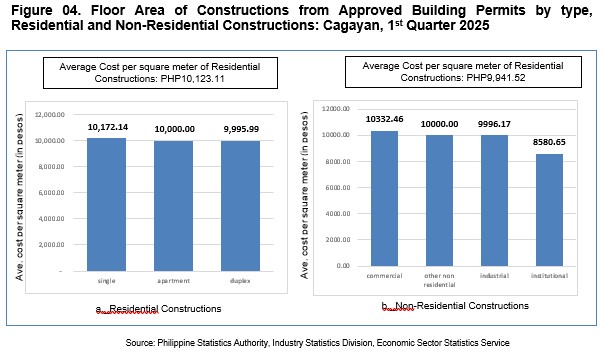
DEFINITION OF TERMS
(Adopted from the Revised and Updated IRR of the National Building Code)
Building refers to any independent, free-standing structure comprised of one or more rooms or other spaces, covered by a roof and enclosed with external wall sor dividing walls, which extend from the foundation to the roof.
Building permit is a written authorization granted by the LBO to an applicant allowing him to proceed with the construction of a specific project after plans, specifications and other pertinent documents have been found to be in conformity with the National Building Code (PD 1096).
Accessorial is a one or two-floor structure divided into several welling units, each dwelling unit having its own separate entrance from the outside.
Addition refers to any new construction which increases the height or area of an existing building/structure.
Agricultural building constructions are buildings used to house livestock, plants and agricultural products such as barn, poultry house, piggeries, stables, greenhouses and grain mill.
Alteration is a construction in a building/structure involving changes in the materials used, partitioning and location/size of openings, structural parts, existing utilities and equipment but does not increase the overall area thereof.
Apartment is a structure, usually of two storeys, made up of independent living quarters, with independent entrances from internal walls and courts.
Commercial building constructions refer to office buildings and all buildings which are intended for use primarily in wholesale, retail and service trades; i.e. stores ,hotels, restaurants, banks, disco houses, etc.
Construction refers to all on-sitework done from site preparation, excavation, foundation, assembly of all the components and installation of utilities, machineries and equipment of buildings/structures.
Floor area of building refers to the sum of the area of each floor of the building measured to the outer surface of the outer walls including the area of lobbies,
cellars, elevator shafts and all communal spaces in multi-dwellings. Areas of balconies are excluded.
Industrial building constructions are all buildings used to house the production, assembly and warehousing activities of industrial establishments; i.e. factories, plants, mills, repair shops, machine shops, printing press, storage plant, electric generating plants.
Institutional building constructions are buildings which primarily engaged in providing educational instructions and hospital/health care; ports, airports and other government buildings;
i.e. school, museums, libraries, sanitaria, churches, hospitals.
Non-residential building constructions includes commercial, industrial, agricultural and institutional buildings.
Other non-building constructions include cemetery structures, street furniture, waiting sheds, communication towers, etc.
Other residential construction consists of school or company staff houses, living quarters for drivers and maids and guardhouses.
Renovation is any physical change made on structures to increase the value, quality and to improve the aesthetic.
Repair is a remedial work done on any damaged or deteriorated portion/s of a building/structure to restore its original condition.
Residential building construction is a building for which its major parts or more than half of its gross floor area is built for dwelling purposes. This type of building can be of the single type, duplex, an apartment and/or accessorial and residential condominium.
Single type building construction is a complete structure intended for a single family or household, i.e. bungalow,2-storey house, nipa hut.
Total value of construction refers to the sum of the cost of building, electrical, mechanical, plumbing, and others. The value is derived from the approved building permit and represents the estimated value of the building or structure when completed.

